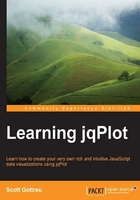
What this book covers
Chapter 1, Getting Started, will briefly give an introduction on how to create a jqPlot object and how the plugin handles data. Then, we'll start creating our first charts, as well as looking at different options for formatting lines and marks.
Chapter 2, More Line Charts, Area Charts, and Scatter Plots, discusses the different ways in which you can load data into your chart, including using AJAX to a remote service. Then, we'll move on to discussing what area charts and scatter plots are, and their best uses.
Chapter 3, Bar Charts and Digging into Data, discusses the best uses of bar charts. We'll also see different options for axis and tick labels including rotatable labels. We'll finish up with clickable data points and will look at how to use these to drill down into more complicated data.
Chapter 4, Horizontal and Stacked Bar Charts, teaches you about horizontal and stacked bar charts. We'll also look at axis padding and positioning of data point labels.
Chapter 5, Pie Charts and Donut Charts, discusses the specific uses of pie charts and donut charts. We'll also see some specific options for pie charts.
Chapter 6, Spice Up Your Charts with Animation, Tooltips, and Highlighting, teaches how to animate your own charts and how to create tooltips. We'll also cover data point highlighting and cursor highlighting.
Chapter 7, Stock Market Charts – OHLC and Candlestick Charts, discusses OHLC and candlestick charts, and their specific uses. We'll also learn the method to format the text included in the tooltips.
Chapter 8, Bubble Charts, Block Plots, and Waterfalls, looks at some different charts that are heavier on the visualization of data over the representation of the data.
Chapter 9, Showing Real-time Data with Our Charts, discusses the methods that allow us to redraw or recreate a given plot after it is has been generated. We'll take this newfound knowledge and see how to update our charts automatically at set intervals.
Chapter 10, Beautifying and Extending Your Charts, explains how to create different themes for our plots and the various CSS options available to style our charts.
Chapter 11, Bringing it All Together, combines everything you have learned and merges the different chart types into one plot, as well as styling your new charts. You will also see how jqPlot can be extended with the new rendering plugins.
Appendix, Answers, helps us find the answers to all the learning questions found throughout the book.